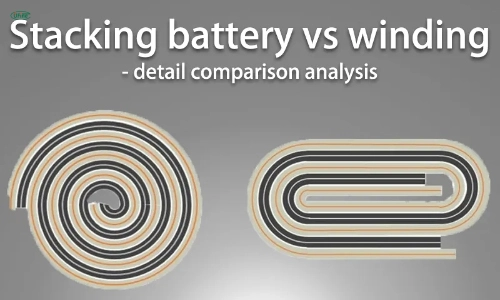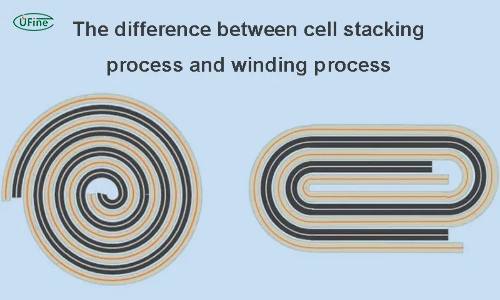What are stack batteries and winding batteries? Layering materials make stack batteries while winding materials create winding batteries into a spiral. Both have unique advantages and disadvantages. Let’s dive into the world of these two battery technologies and discover more!
Part 1. What is a stack battery?
Manufacturing Process:
Stack batteries are rechargeable batteries that utilize a layered construction method. The manufacturing process of stack batteries involves assembling multiple layers of electrode, separator, and electrolyte materials. Electrodes, typically composed of lithium or other active materials, are coated onto conductive substrates. Separators, often made of porous materials like polyethylene or ceramic, are placed between the electrodes to prevent electrical short circuits. Electrolytes, which conduct ions between the electrodes, can be liquid or solid, depending on the battery design.
Layered Structure and Design:
Stack batteries consist of alternating layers of electrodes and separators arranged in a sandwich-like structure. Electrodes are stacked one on top of another, with separators in between to maintain physical separation and allow for ion transport. The number and thickness of layers can vary depending on the desired energy density and battery performance characteristics. This stacked configuration maximizes the active surface area within the battery, allowing for efficient energy storage and release. Advanced manufacturing techniques, such as roll-to-roll or vacuum deposition, produce uniform and precise layers.
Part 2. Advantages of stack battery technology
High Energy Density:
The layered design of stack batteries enables them to achieve high energy density, providing longer operating times between charges.
Compact Form Factor:
Stack batteries can be made in compact sizes, making them suitable for portable electronic devices and electric vehicles.
Customizable Configurations:
Manufacturers can tailor stack batteries to meet specific performance requirements by adjusting layer thicknesses and materials.
Enhanced Safety Features:
Stack batteries can incorporate safety mechanisms such as thermal shutdown systems and flame-retardant separators to reduce the risk of overheating and fires.
Scalability:
Stack battery production processes are scalable, allowing mass production to meet the growing demand for energy storage solutions.
Part 3. Disadvantages of stack battery technology
Complex Manufacturing Process:
The production of stack batteries involves intricate layering and assembly techniques, leading to higher manufacturing costs and longer lead times than simpler battery designs.
Limited Flexibility:
Stack batteries may have limited flexibility compared to other battery types, making them less suitable for applications that require bending or shaping to fit specific form factors.
Potential for Delamination:
In some cases, the layers within stack batteries may delaminate or separate over time, reducing the battery’s performance and lifespan.
Risk of Internal Short Circuits:
Despite the presence of separators, stack batteries still pose a risk of internal short circuits due to the proximity of electrode layers, mainly if manufacturing defects or damage occur during use.
Lower Power Density:
While stack batteries excel in energy density, they may have lower power density than other battery technologies, resulting in slower discharge rates and reduced performance in high-power applications.
Limited Scalability:
Scaling up production of stack batteries may present challenges due to the complexity of the manufacturing process and the need for precise control over layer thicknesses and materials, potentially limiting their widespread adoption in large-scale energy storage systems.
Part 4. What is a winding battery?
Manufacturing Process:
The manufacturing process of winding batteries involves winding together layers of electrode and separator materials into a spiral configuration around a central core or mandrel. This process is typically automated and requires precision to ensure uniform winding tension and alignment of the electrode layers.
Layered Structure and Design:
Winding batteries feature a spiral-wound construction method comprising layers of electrodes and separators wound around a central core. Electrodes, usually made of lithium-based materials, are coated onto thin metal foils and wound together with separator materials. This layered structure maximizes the active surface area within the battery, allowing for efficient energy storage and release.
Part 5. Advantages of winding battery technology
Compact Design:
Winding batteries feature a cylindrical or prismatic shape, optimizing space utilization in various devices and applications with limited space availability.
High Energy Density:
Similar to stack batteries, winding batteries offer impressive energy density, ensuring long-lasting power in a relatively small size.
Customizable Configurations:
Winding batteries provide manufacturers with flexibility in design, allowing customization of battery cells’ size, shape, and capacity to meet specific application requirements.
Efficient Thermal Management:
The cylindrical or prismatic shape of winding batteries facilitates effective heat dissipation, reducing the risk of overheating and enhancing overall safety.
Scalability:
Winding battery production processes are scalable, enabling mass production to meet the increasing demand for energy storage solutions.
Part 6. Disadvantages of winding battery technology
Complex Manufacturing Process:
Despite their advantages, winding batteries entail intricate manufacturing processes involving precise electrode and separator materials winding. This complexity may increase production costs and longer lead times than simpler battery designs.
Limited Form Factor Flexibility:
Winding batteries typically have fixed shapes, which may need to be more easily adaptable to applications requiring unconventional battery shapes or sizes. This limitation could restrict their use in specific devices or systems.
Internal Short Circuit Risks:
Despite using separators, winding batteries still pose a risk of internal short circuits due to the proximity of electrode layers. This risk may increase if manufacturing defects or damage occur during production or use, potentially compromising battery safety and performance.
Challenges in Scalability:
Scaling up the production of winding batteries can be challenging due to the complexity of the winding process and the need for precise control over winding tension and alignment. This scalability issue may hinder their widespread adoption for large-scale energy storage applications.
Recycling Difficulties:
The complex construction of winding batteries may need to be more flexible with recycling than simpler battery designs. Disassembling and separating the various components for recycling purposes may require specialized processes, raising concerns about environmental impact and end-of-life management.
Part 7. Stack battery vs. winding battery
Battery Shapes and Structures:
- Stack batteries are usually rectangular or square. Layering parts like electrodes, separators, and electrolytes make them. These batteries fit nicely in spaces with specific shapes.
- Winding batteries are cylindrical or prismatic. They are made by winding parts into a spiral shape. This makes them flexible and suitable for fitting into tight spaces or matching the shape of devices.
Structural Stability:
- Stack batteries generally exhibit excellent structural stability due to their layered construction, which provides mechanical solid support and resistance to deformation.
- Winding batteries may face challenges in maintaining structural integrity, especially during fast charging or discharging cycles, as the spiral winding may experience mechanical stress and deformation over time.
Fast Charging Adaptation:
- Stack batteries can adapt to fast charging technologies relatively well, as the layered structure allows for efficient ion transport and minimizes internal resistance.
- Winding batteries may exhibit slower charging adaptation due to potential issues with ion diffusion and heat dissipation within the spiral-wound configuration, which could lead to longer charging times or reduced battery lifespan.
Cycle Life:
- Thanks to their robust construction and optimized electrode materials, stack batteries often boast a longer cycle life than winding batteries.
- Winding batteries may have a shorter cycle life due to mechanical stress on the wound layers and potential electrode degradation over repeated charge-discharge cycles.
Energy Efficiency:
- Stack batteries offer high energy efficiency, with minimal energy loss during charging and discharging processes.
- Winding batteries may experience slightly lower energy efficiency due to factors such as internal resistance and heat generation during operation.
Flexibility:
- Stack batteries may offer more flexibility in customizing the number and thickness of layers to achieve desired performance characteristics.
Winding batteries provide:
- Flexibility in design.
- Allowing for customization of battery size.
- Shape.
- Capacity to suit specific application requirements.
Safety Features:
- Both stack and winding batteries incorporate safety mechanisms such as thermal management systems and shutdown separators to prevent overheating and minimize fire risk.
Applications:
- Stack batteries are commonly used in electronic devices, electric vehicles, and grid energy storage systems.
- Due to their compact form factor and efficient energy storage, winding batteries find applications in portable electronics, medical devices, and automotive applications.
Cost-effectiveness:
- The manufacturing complexity of stack batteries may result in higher production costs than winding batteries.
Part 8. Final thoughts
Choosing the correct battery depends on your needs. Stack batteries and winding batteries each have their strengths. Pick the one that best fits your device.
Related Tags:
More Articles

LiPo Battery Discharge Rate Guide & Calculation Tips
Understand LiPo battery discharge rates, C-ratings, and how to calculate max current. Essential guide for RC, drones, and electronics users.
High‑Capacity 3S LiPo Batteries: 5000 mAh vs. 10000 mAh
Compare 3S LiPo 5000mAh vs 10000mAh batteries by weight, power, and use. Find the best fit for your drone, RC car, or boat setup.
Top 5 Applications for Small 3S LiPo Batteries
Small 3S LiPo batteries power drones, RC gear, wearables, and robotics with high energy and low weight. Making them ideal for compact electronics projects.
Building and Charging Your Own 3S LiPo Pack: A Step‑by‑Step Guide
Learn how to build, balance, and charge a 3S LiPo battery pack safely at home with this complete DIY guide for hobbyists and beginners.
How to Choose the Right LiPo Battery Plug Type?
Discover the best LiPo battery plug types, how to choose them, and expert tips for safe usage, soldering, and maintenance.





